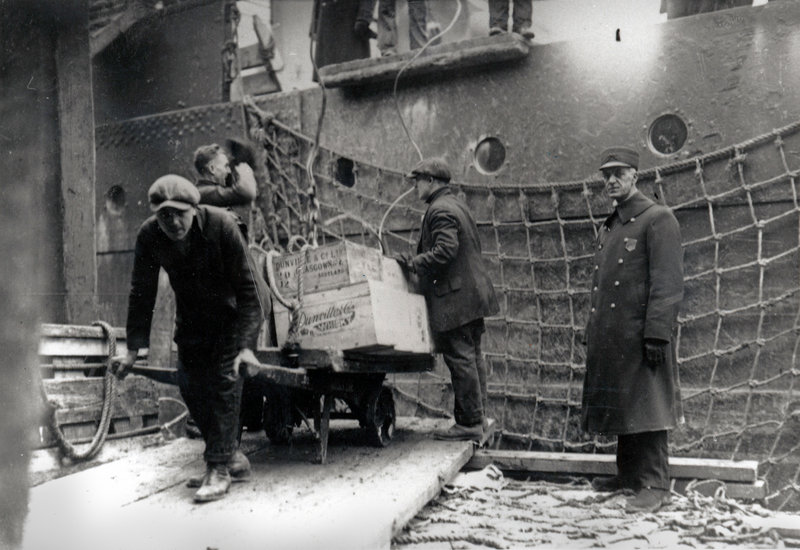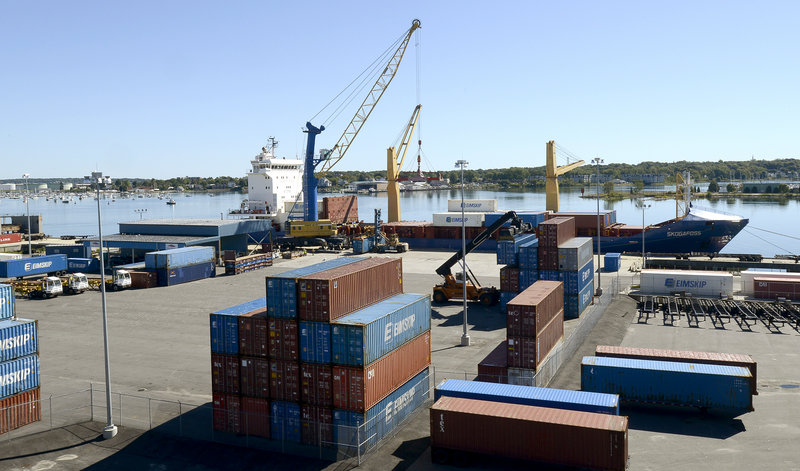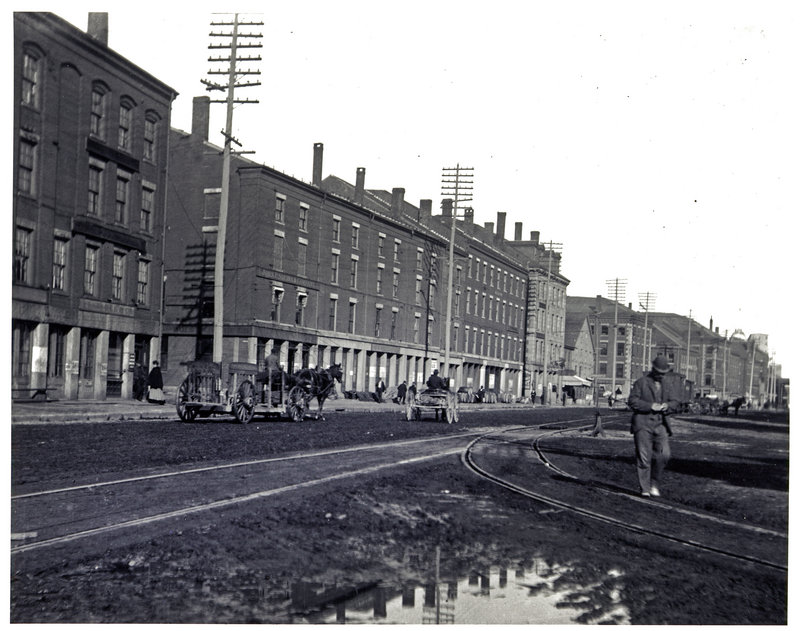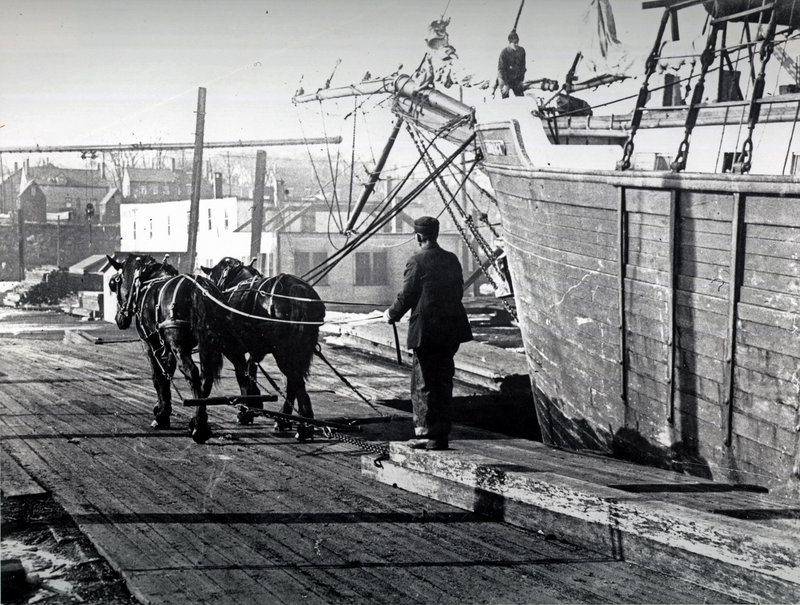As World War I came to a close in 1919, Portland’s waterfront was among the largest ports on the East Coast, a rival to Boston, Philadelphia and Baltimore.
That was the year the union representing Portland’s longshoremen reached its peak enrollment, with 1,366 active members.
Today, the union represents just 26 part-time and three full-time workers.
Those numbers tell the story of the port’s long and dramatic decline from its glory days when it served as the winter port for much of eastern Canada. They also explain why state officials are so eager to nurture the port’s new trading partnership with Iceland, a connection with the potential to expand opportunities for global trade through the state’s largest seaport.
The port’s early success, and its newfound hope, are due to geography.
No other major port in America is situated closer to Europe. And because of strong tides that churn the water column in the Gulf of Maine, deeper, warmer water is brought to the surface in winter, keeping the port ice-free.
The lack of ice was a crucial factor in the explosive growth the port experienced from the mid-1800s through the end of the first World War.
Quebec and Ontario needed rail access to a port on the Atlantic Coast because the St. Lawrence River was frozen all winter.
In February 1845, with the Montreal Board of Trade poised to approve a plan to build a railroad to Boston, Portland businessman John Poor made a historic journey to Montreal during a blizzard to persuade the board to delay its decision and instead consider a route between Montreal and Portland.
While Portland was 100 miles closer to Montreal by rail and a half-day’s sail closer to Europe than Boston, the businessmen in Montreal doubted that Portland, with a population of only 16,000, could generate enough capital to help finance the project.
Poor convinced the board that the city would rally around the project, and work crews in 1848 began extending a rail line north from the bottom of India Street.
By 1853, the 292-mile line between Portland and Montreal was complete, connecting the port to western Canada and the U.S. Midwest. In 1916, the peak of Portland’s trans-Atlantic trade, the Grand Trunk Railway Company’s grain elevators on the eastern waterfront loaded 37 million bushels of grain from western Canada onto steamships bound for Europe.
Exports far outpaced imports, said Michael Connolly, who lives on Munjoy Hill and teaches history at Saint Joseph’s College of Maine in Standish.
Records at the U.S. Custom House show that 119 ships entered the port that year with cargo for import, while 227 vessels departed with cargo for export.
The port’s growth also transformed Portland into a rail hub.
In the 1850s, the Portland waterfront was filled in to create Commercial Street — a wide street with room for tracks and lined with new warehouses, train sheds and long new wharves.
At the site of what is now the city-owned International Marine Terminal — the terminal where containers come and go from Iceland — rail lines ran along several warehouses on adjacent land and could accommodate 1,050 rail cars.
The port was busiest in winter. In the spring, when the St. Lawrence River became passable again for ships, Portland’s waterfront grew much quieter.
Many Portland longshoremen traveled to Montreal in the summer for work, said Connolly, whose grandfather loaded cargo on Portland’s docks.
The boom also changed the face of the waterfront.
Before the link to Montreal, many African-Americans worked on Portland’s waterfront. But when the work became more lucrative, Irish immigrants pushed them out, Connolly said.
The Irish in the mid-1860s established a union, the Longshoremen’s Benevolent Association, and in 1881 adopted a bylaw that excluded blacks from joining.
The union also protected older workers, helping them keep jobs even though their bodies were worn out by years of heavy labor, Connolly said.
Dirty jobs, such as loading grain, china clay and coal, got premium pay. Coal shovelers had great physical stamina, he said. The men would dig into the coal using a sharp, pointed attachment to their shovels called a shield.
At the end of every work shift, the men would walk home carrying their shields over their shoulders.
“It was almost like a badge of honor,” Connolly said.
After World War I, Portland’s port began its long decline. Canada began investing heavily in creating the modern ports of Halifax, Nova Scotia, and Saint John, New Brunswick.
Even though Portland was the shortest route to Montreal, Canadians believed it was in their national interests to keep Canadian cargo and profits in Canada, Connolly said.
The port revived somewhat during World War II, when the harbor served as the home port for the North Atlantic fleet, a shipbuilding center and jumping-off point for convoys ferrying cargo to northern Europe.
But another blow came in the 1960s, when the shipping industry worldwide adopted the use of shipping containers and expensive labor-saving machinery.
Cargo volumes in Portland and other small ports declined sharply as a handful of giant ports began to dominate the cargo business.
Portland failed to make the investments needed to keep its port modern and competitive, said Jack Humeniuk, business agent for the longshoremen’s union.
By the 1970s, large sections of Portland’s waterfront were abandoned.
In the early 1980s, Portland’s last link to Europe was severed when a steamship line carrying cargo between Norway and Portland ended its regular service.
The primary cargo operations were oil deliveries for the Portland Pipeline, which sent oil to Montreal in two underground pipelines, and the movement of noncontainerized pulp, paper, coal and salt at Merrill’s Marine Terminal on the western end of Commercial Street.
At the International Marine Terminal, several steamship lines attempted to establish a viable container shipping service between 1991 and 2011, but the on-again, off-again service struggled to keep its customers, Humeniuk said.
In 2009, the terminal was so quiet that the city used it to store snow removed from winter streets.
That year, believing that the state had more resources available to invest in the terminal and manage it, the Portland City Council agreed to lease the terminal to the Maine Port Authority.
That became a turning point for the port, because the port authority’s upgrades made it possible for the Icelandic steamship line, Eimskip, to make Portland its base in North America, Humeniuk said.
The state in recent years has spent $8.5 million on the terminal, including $5 million in federal stimulus funds.
Eimskip, whose service connects Portland with ports in Northern Europe, Iceland and Newfoundland, is not the only good news for the port.
Humeniuk and state officials also hope to begin a domestic cargo service between Portland and New York and New Jersey. The idea is to move more cargo traffic off crowded highways and onto ships on a “marine highway.”
The port authority, in a partnership with McAllister Towing and Transportation, has won a federal contract to design a tug-barge hybrid that, unlike a conventional barge, could carry containers in the open ocean in stormy winter weather.
Coastal cargo service would increase overall volumes at the terminal and also extend Eimskip’s reach into the New York market, said John Henshaw, executive director of the Maine Port Authority.
“If you make the right investments and make the smart decisions, the future of the port looks good,” he said. “But, of course, there are no guarantees.”
Tom Bell can be contacted at 791-6369 or at
tbell@pressherald.com
Twitter: TomBellPortland
Send questions/comments to the editors.







Comments are no longer available on this story